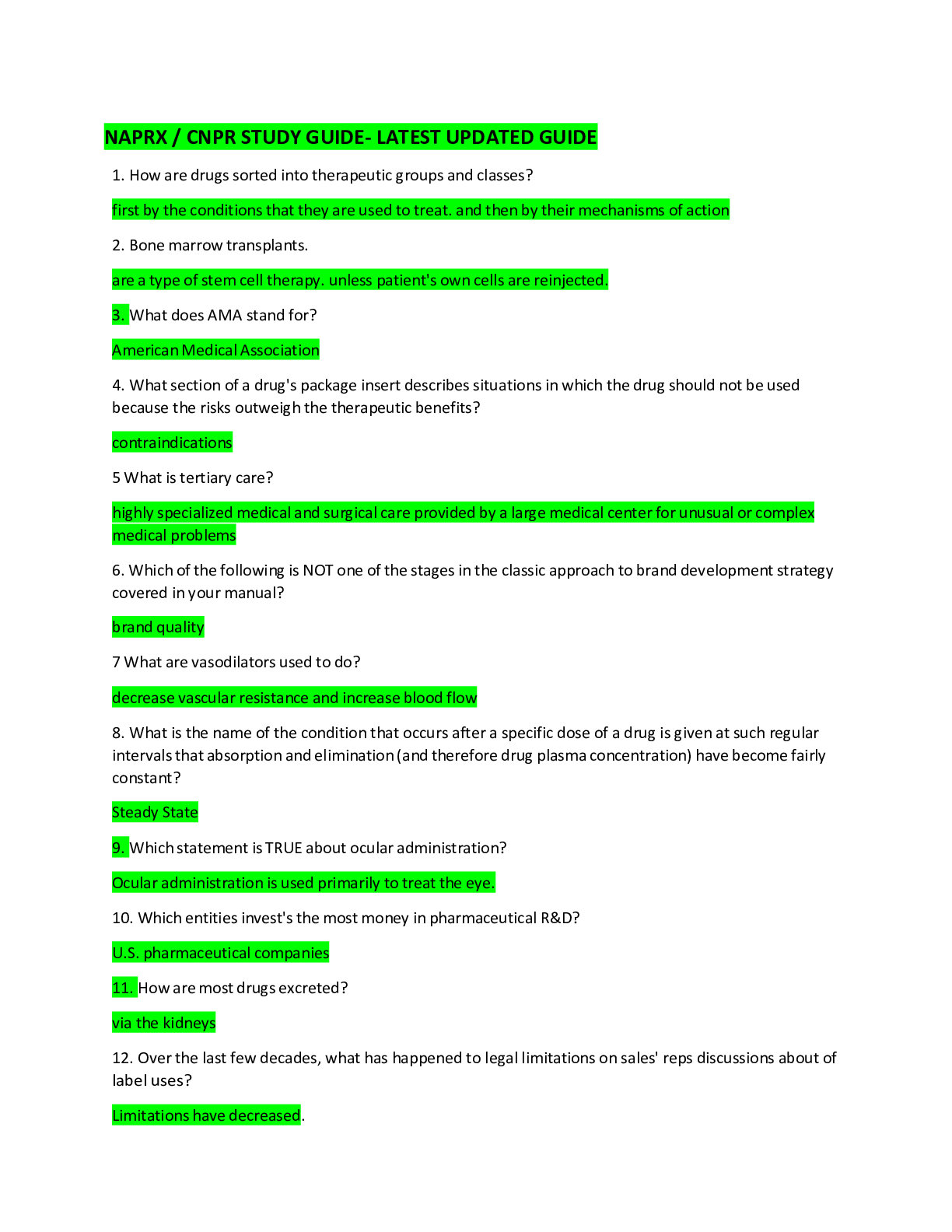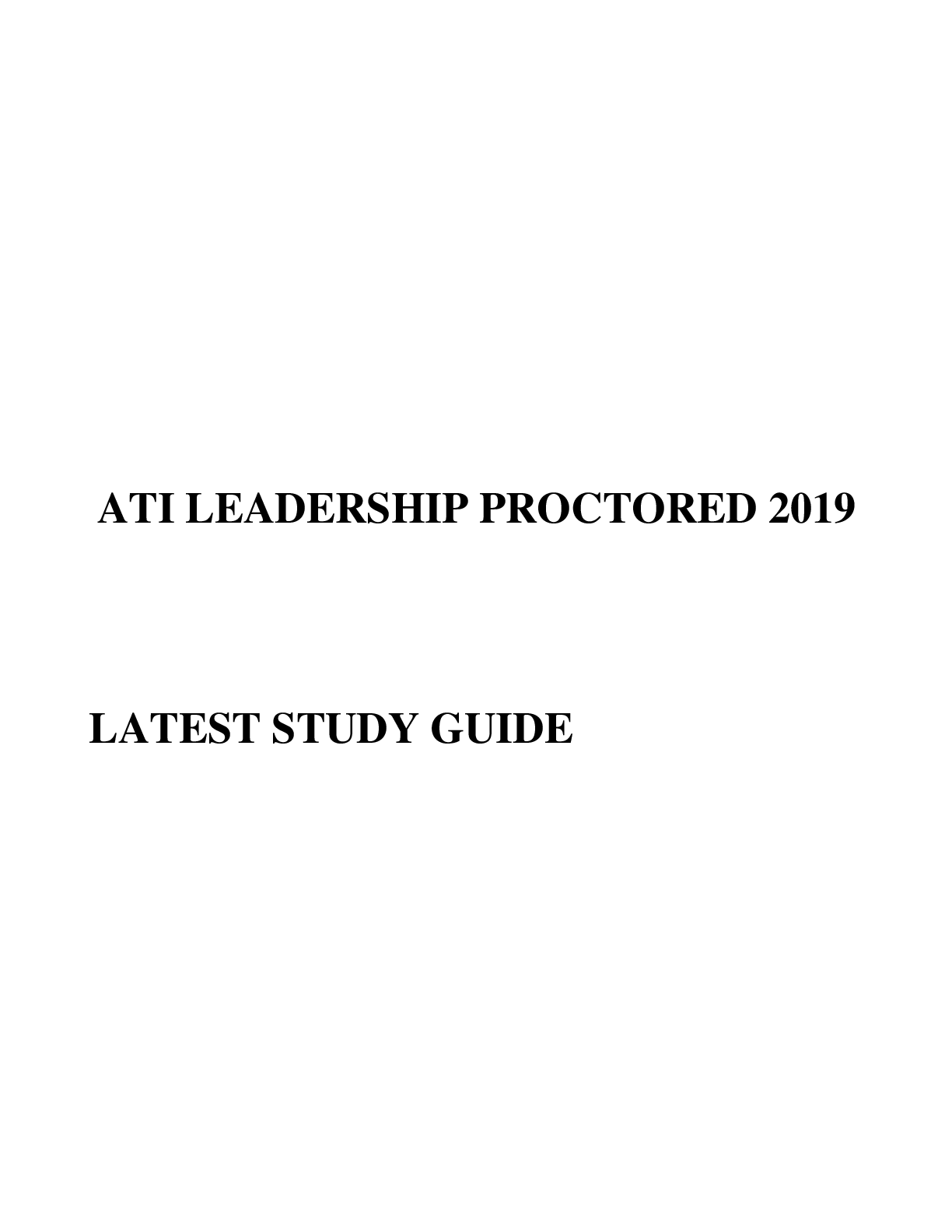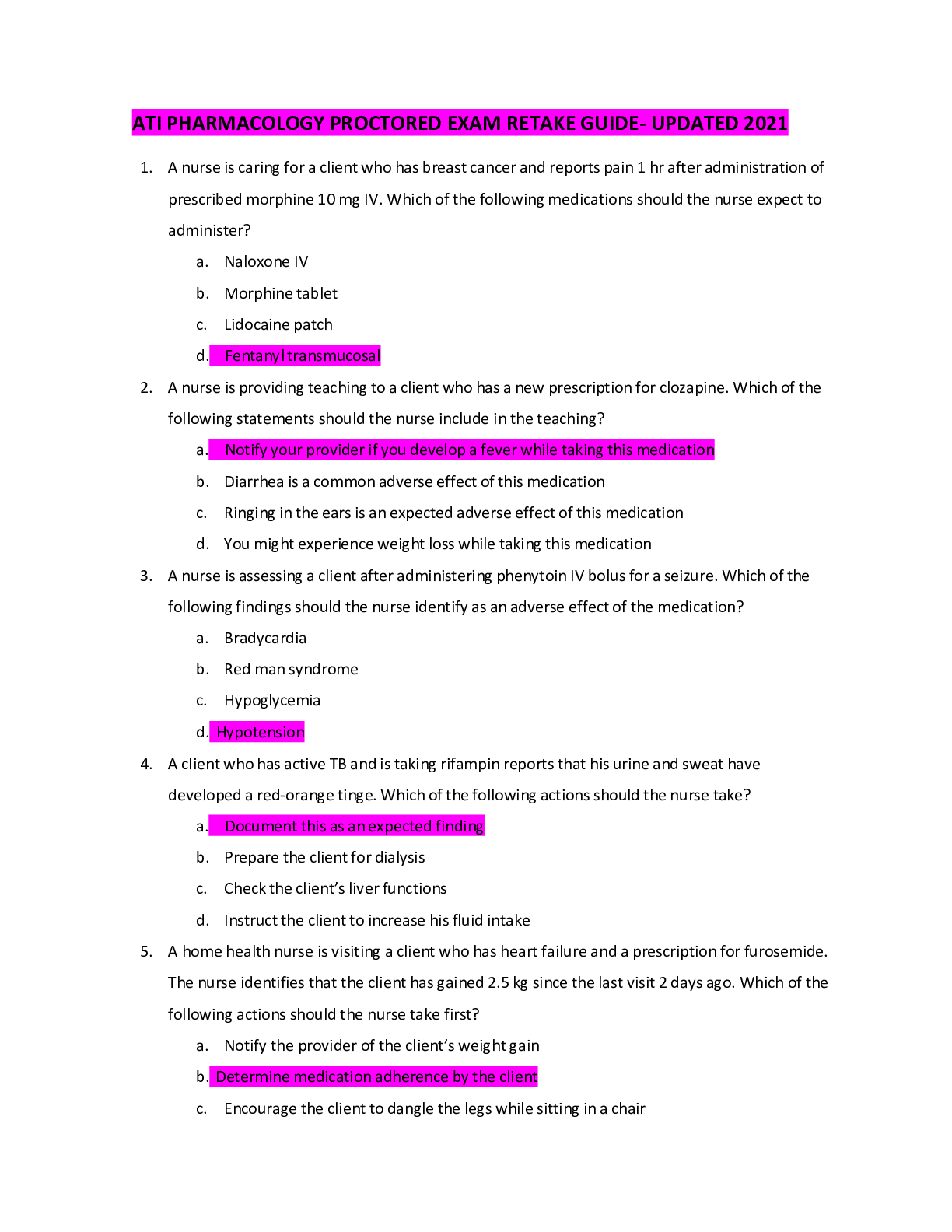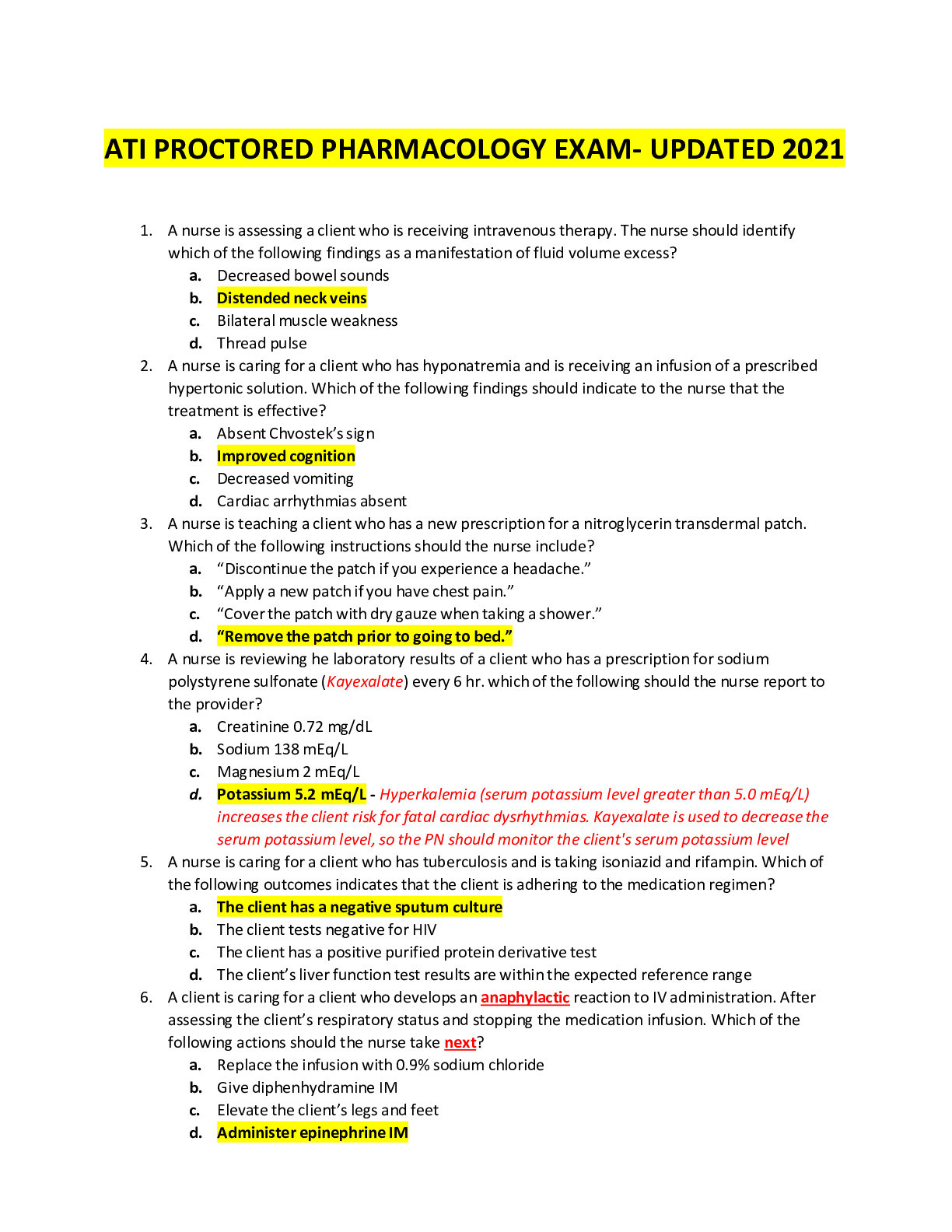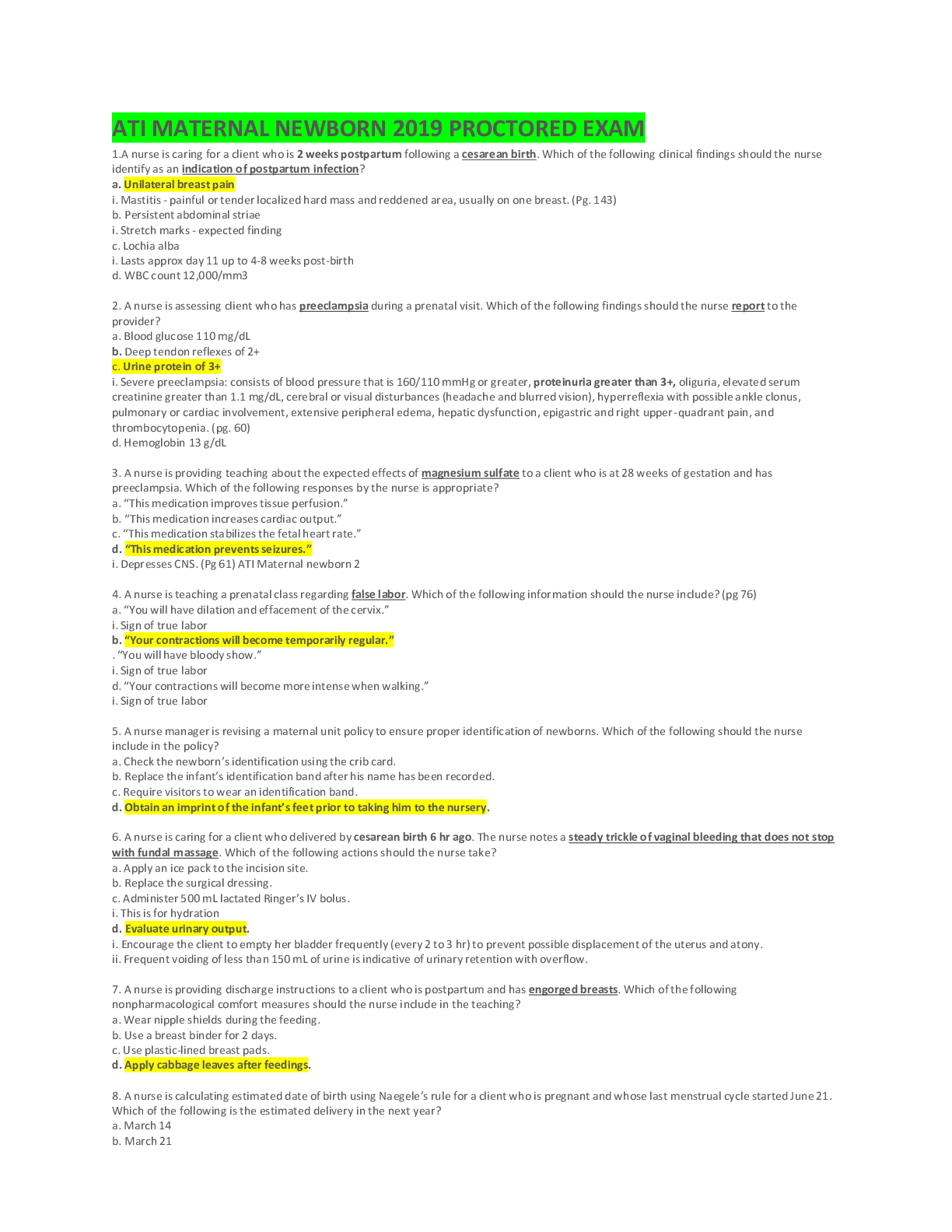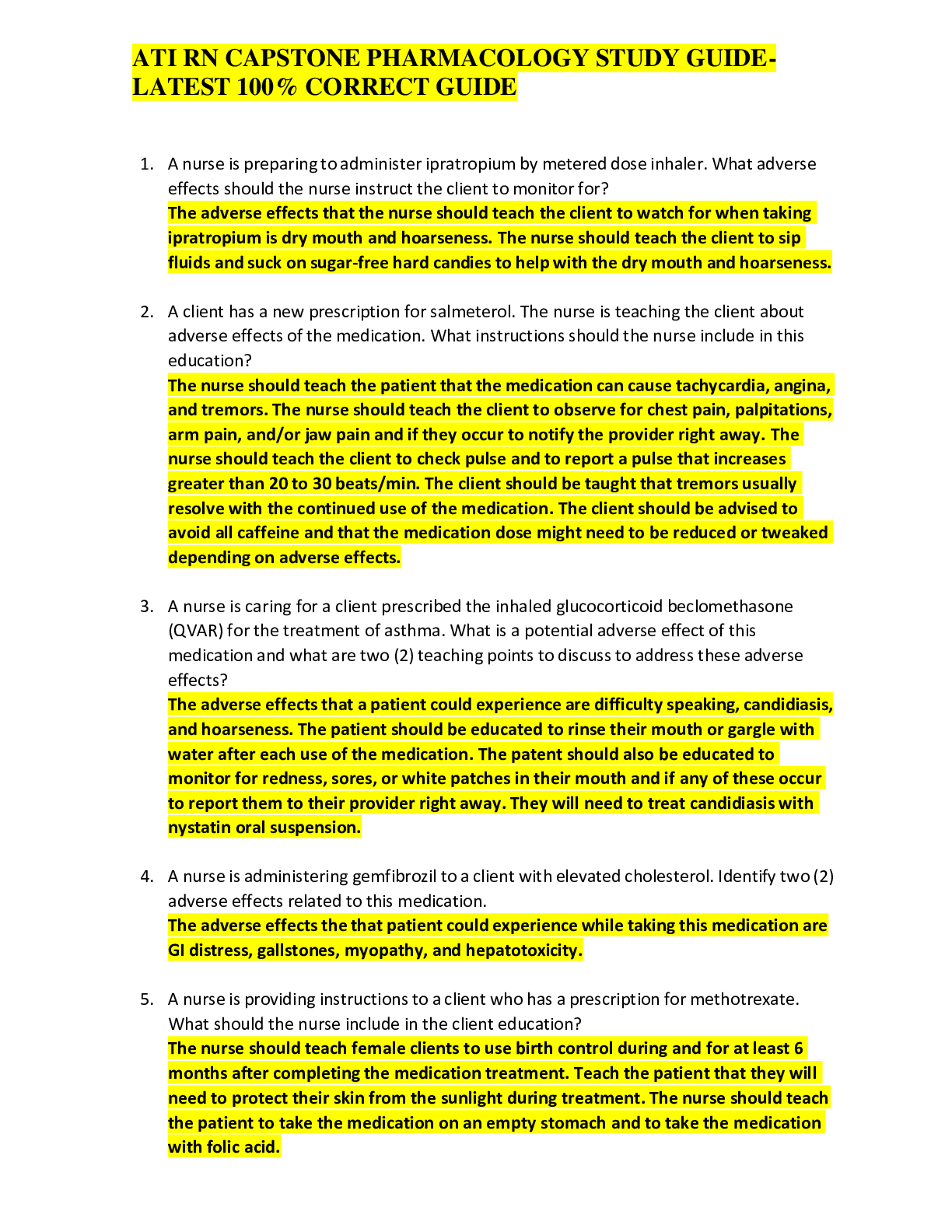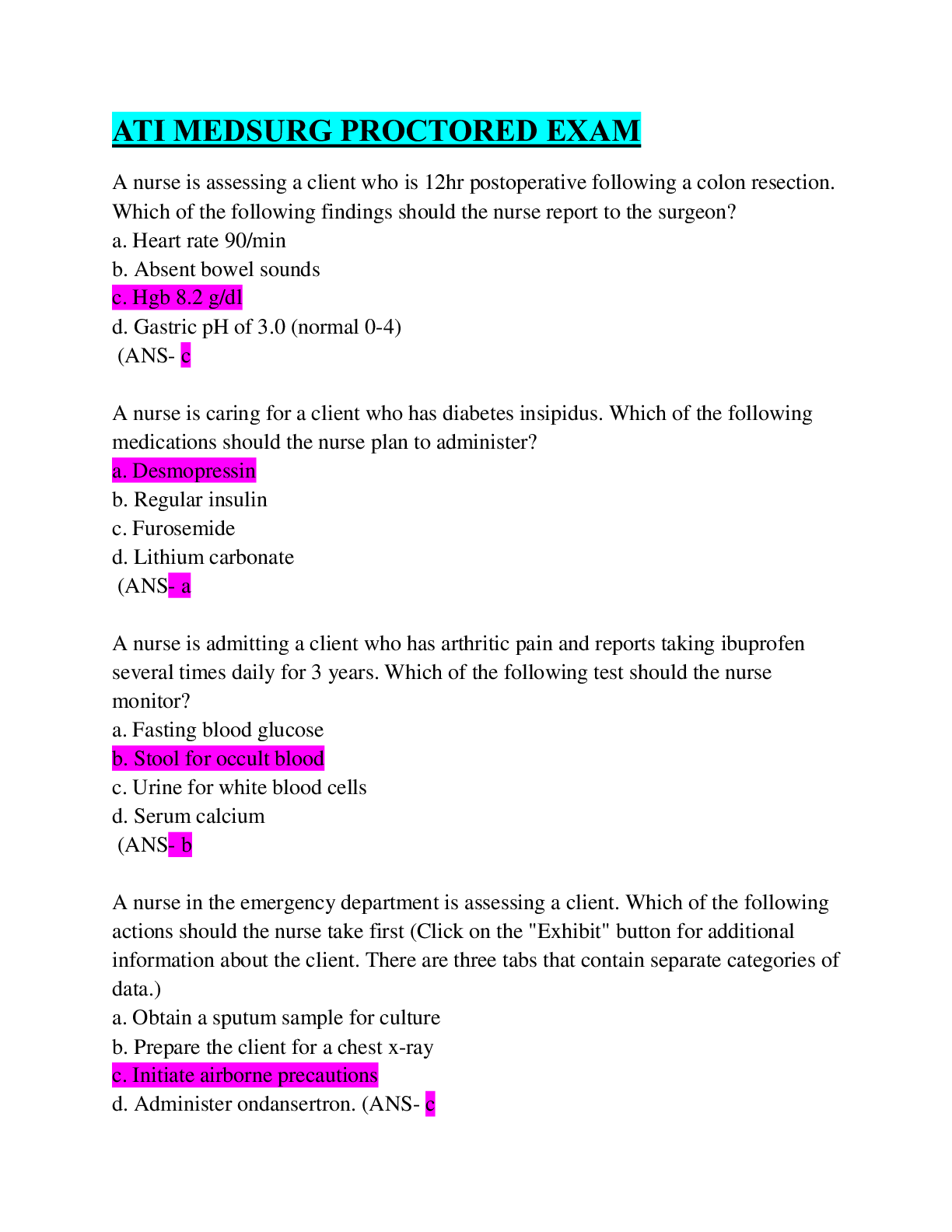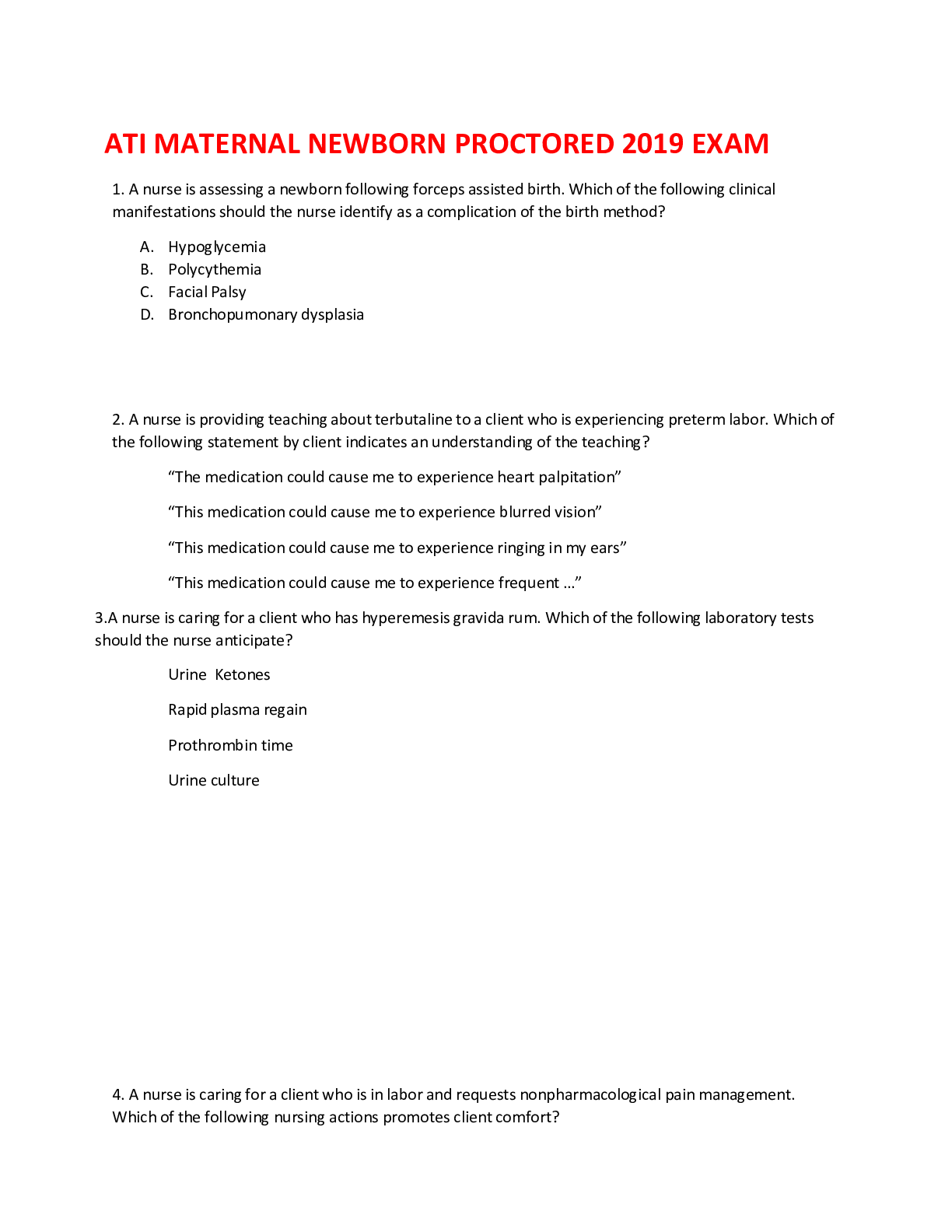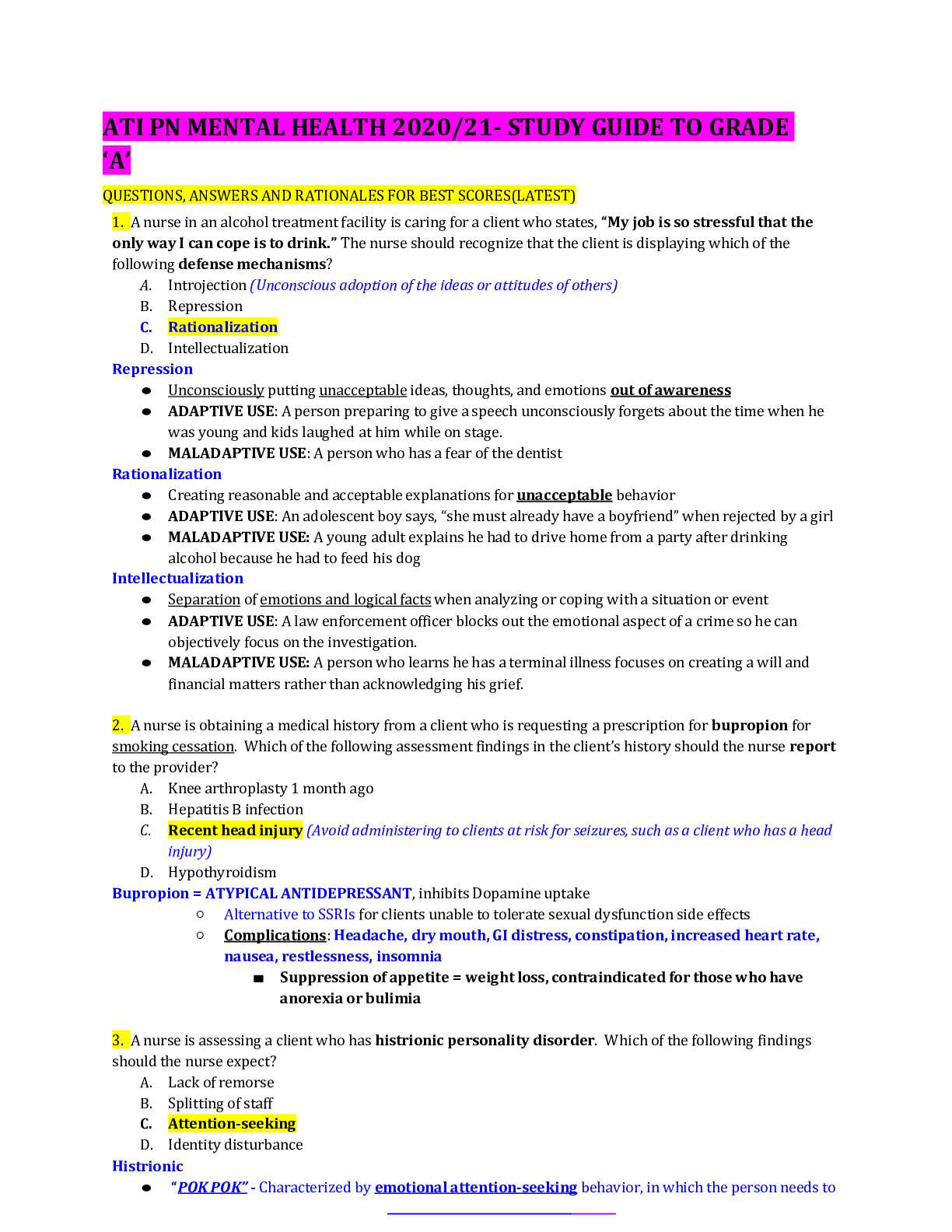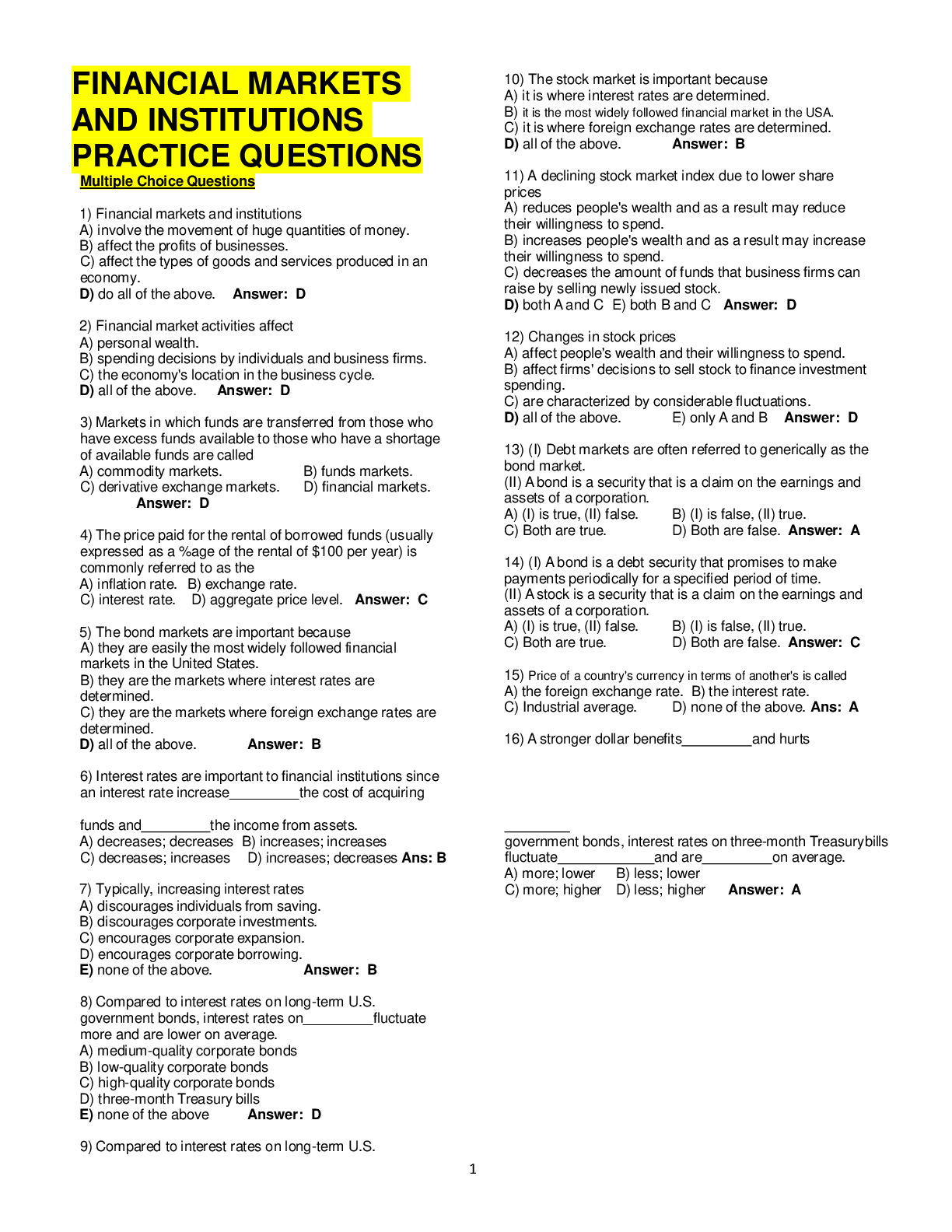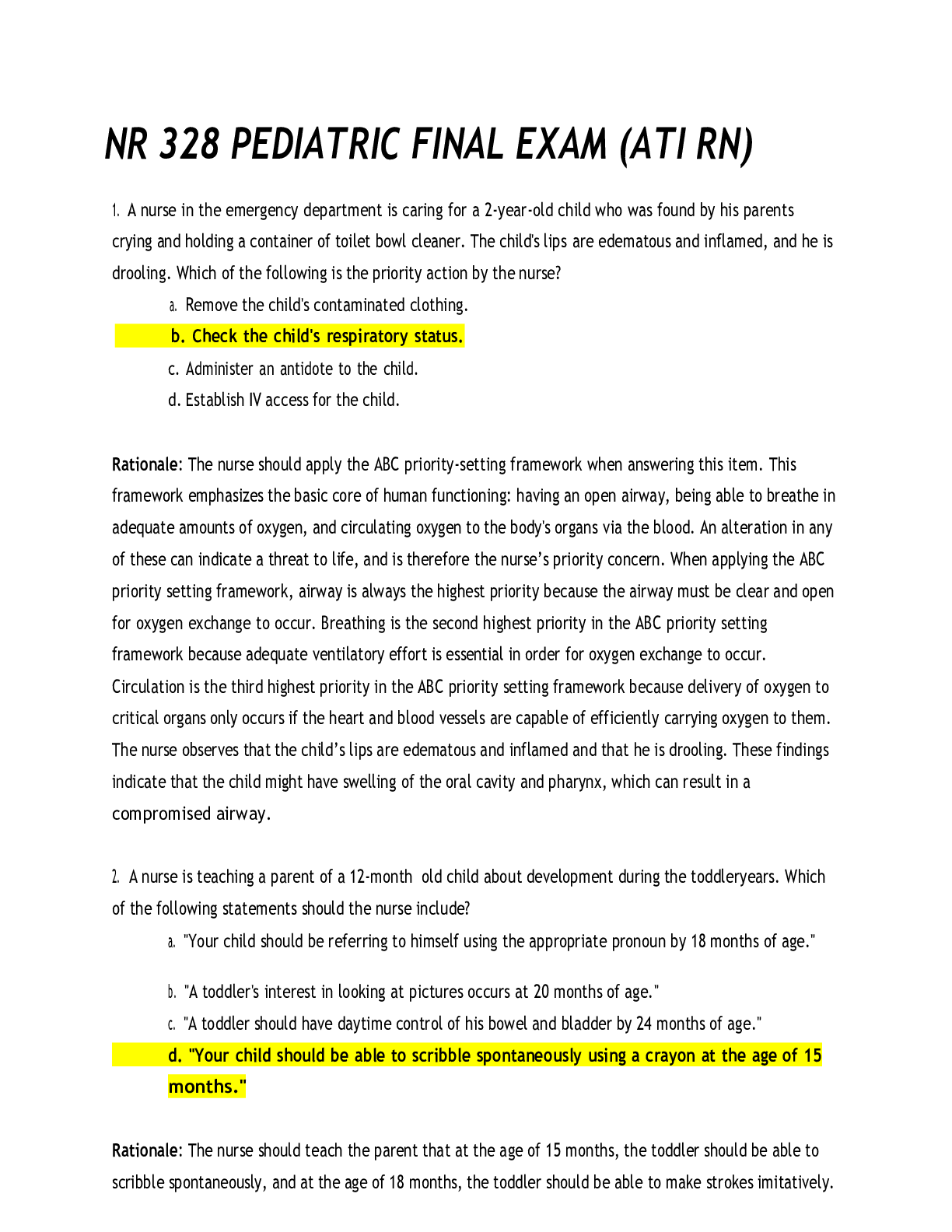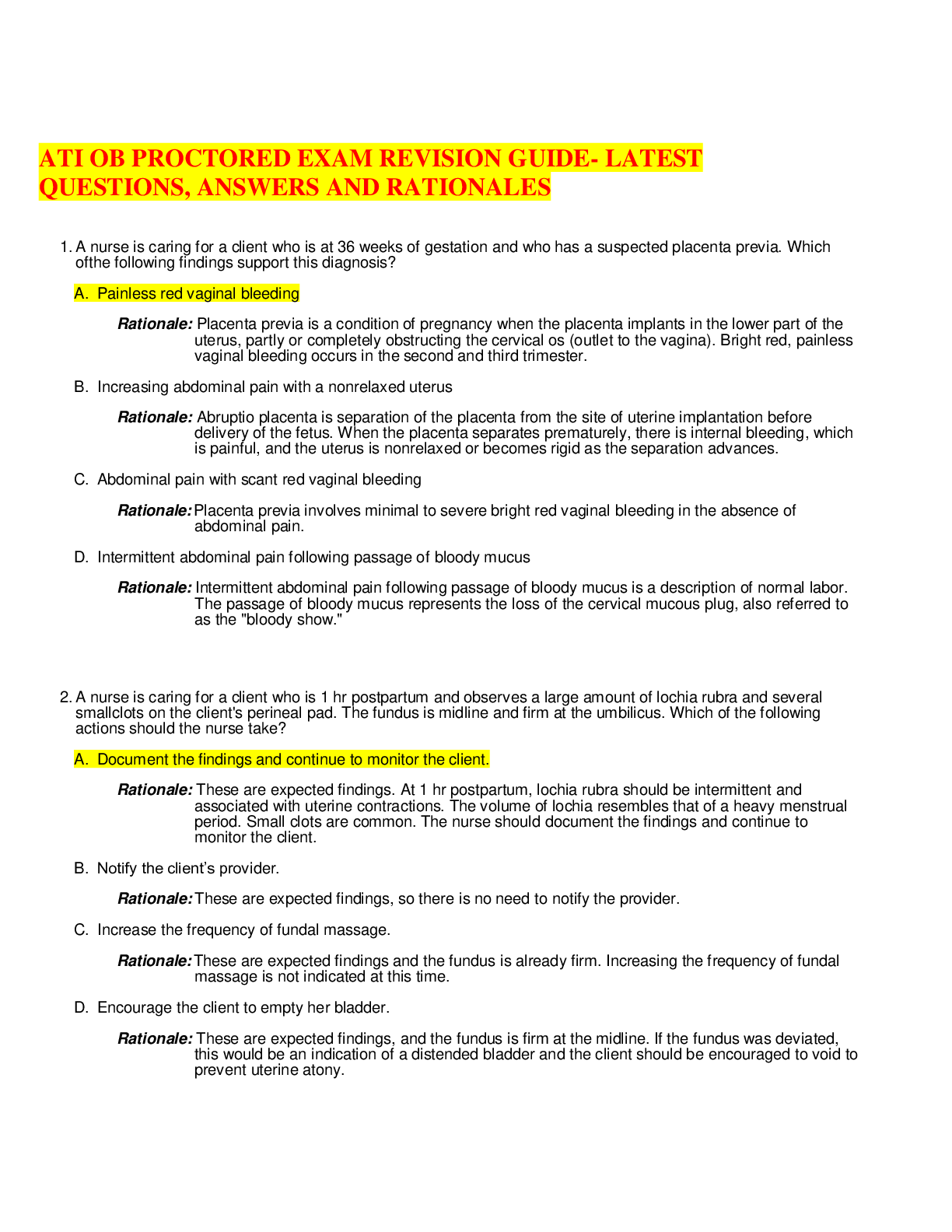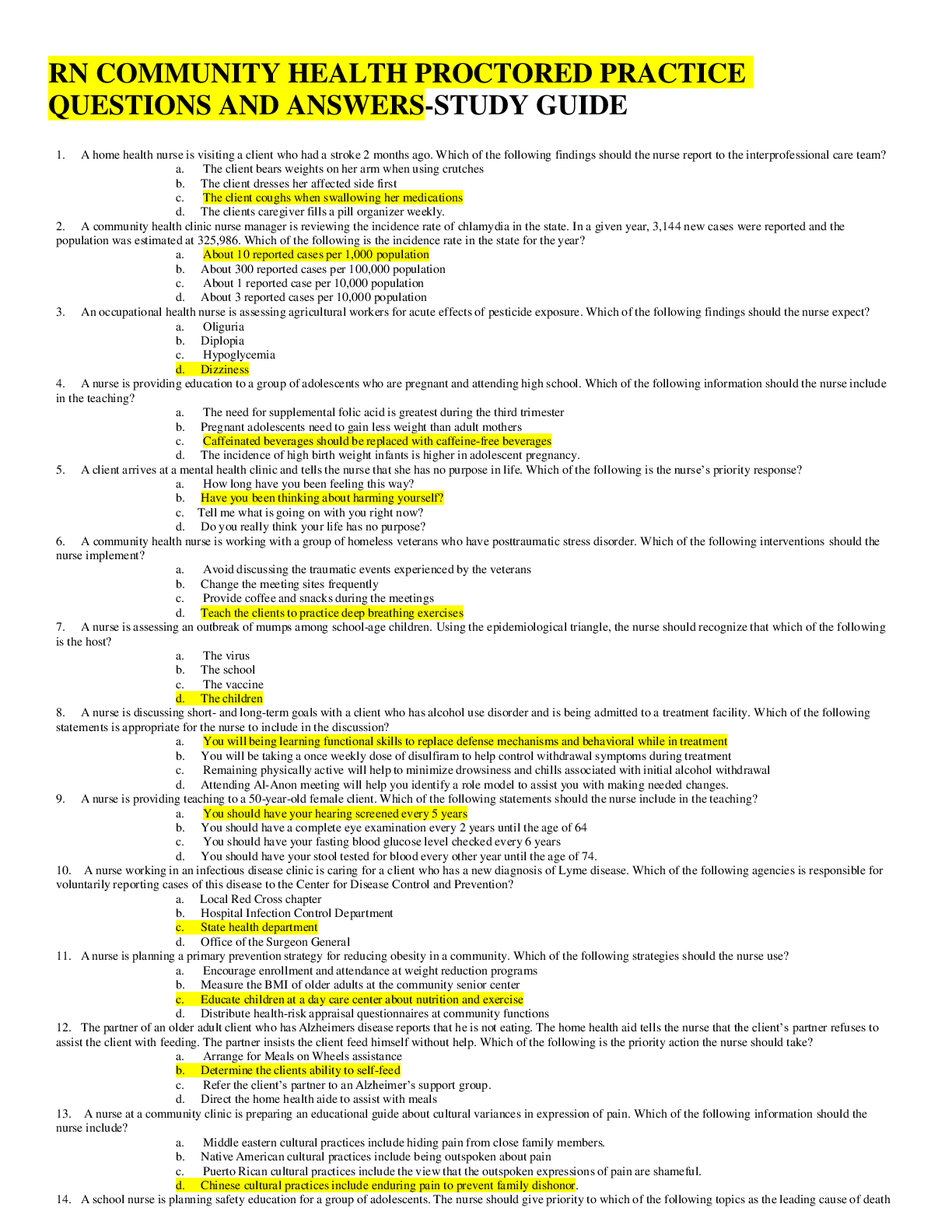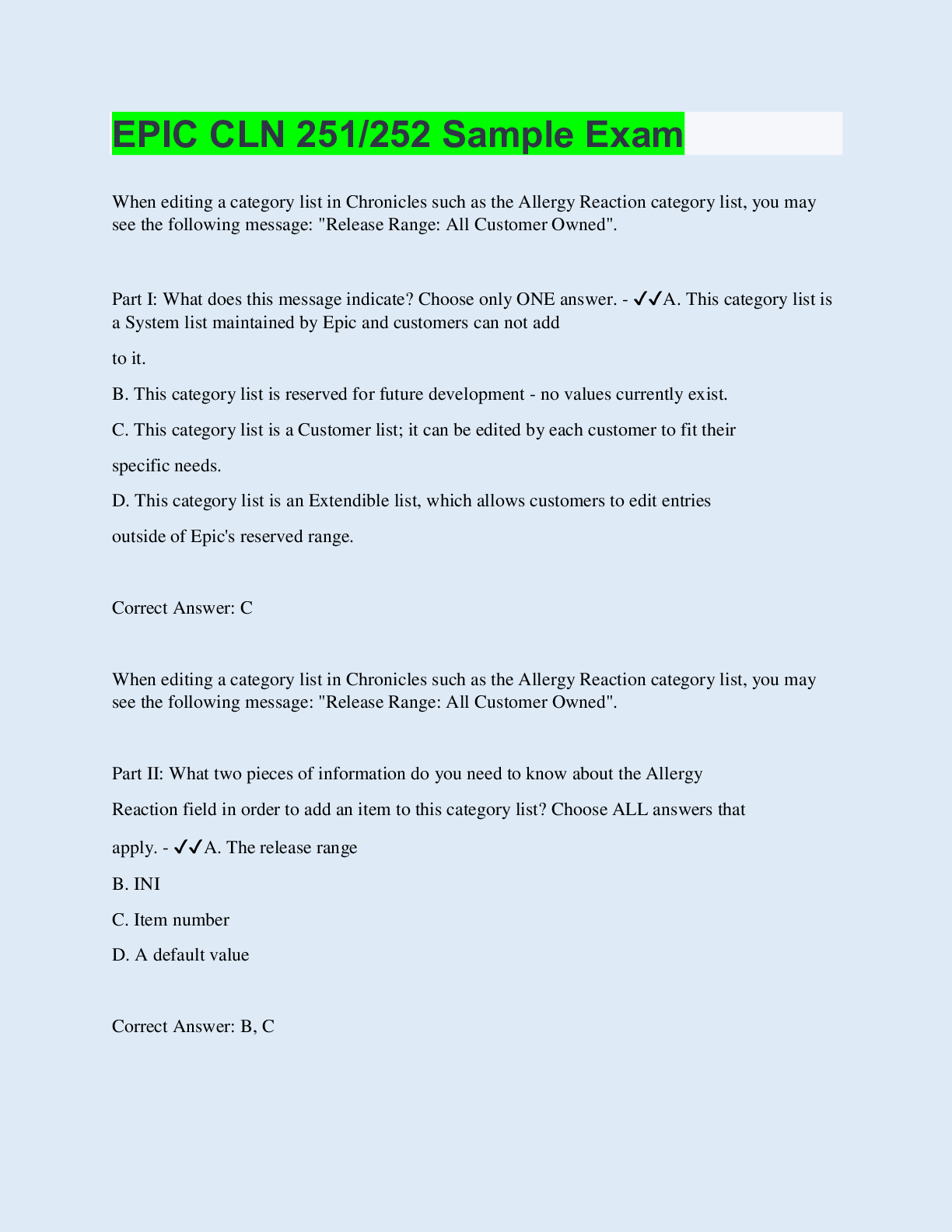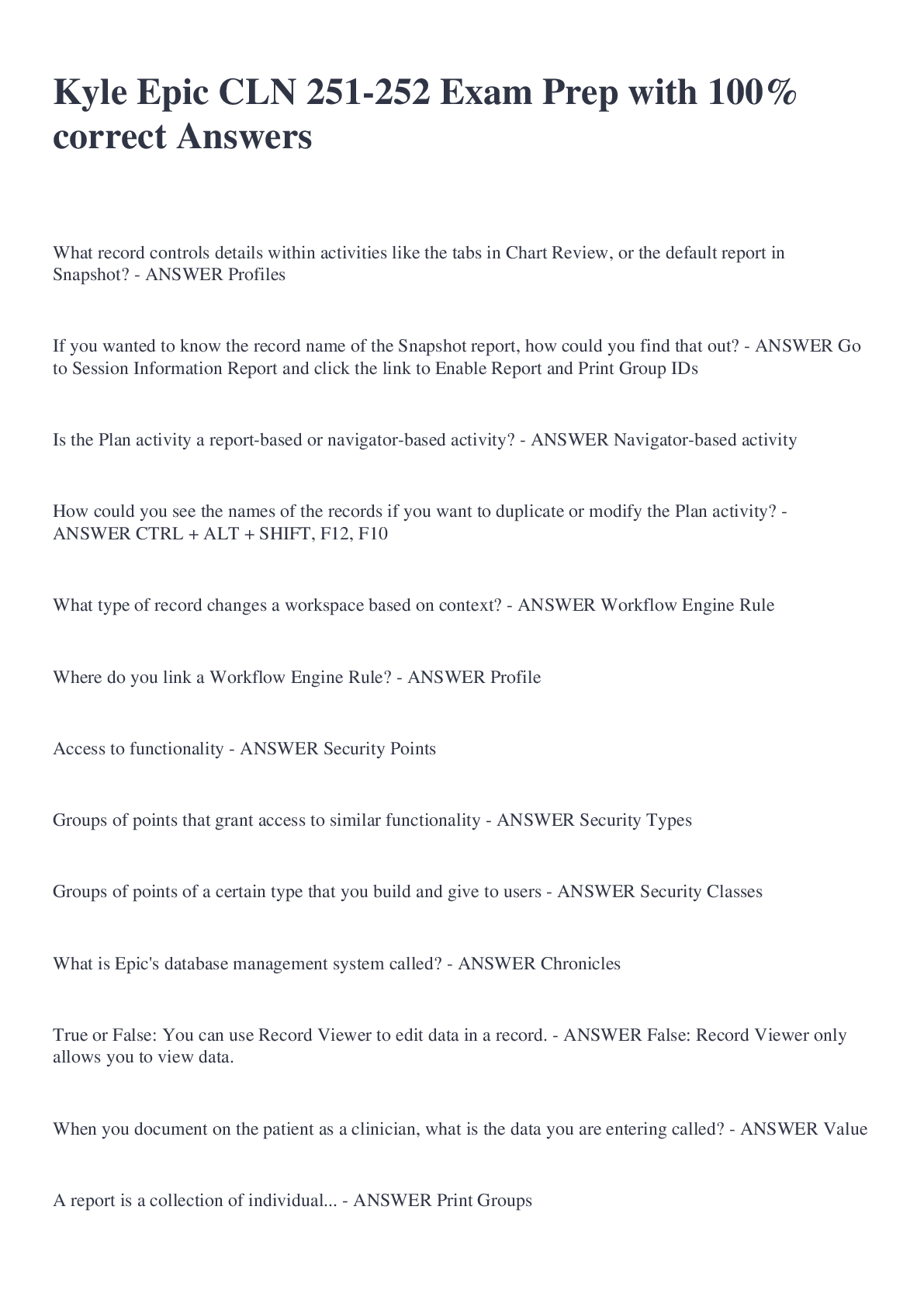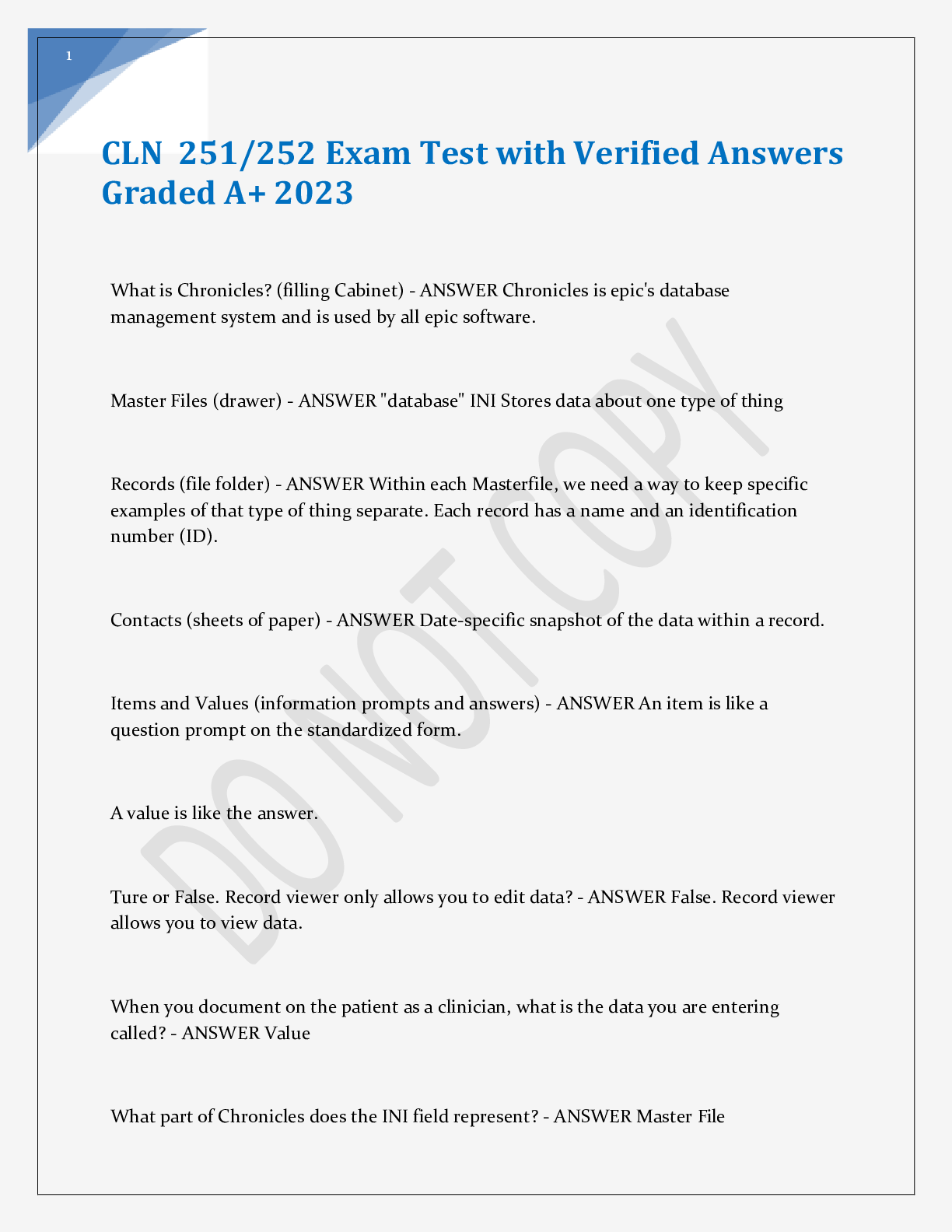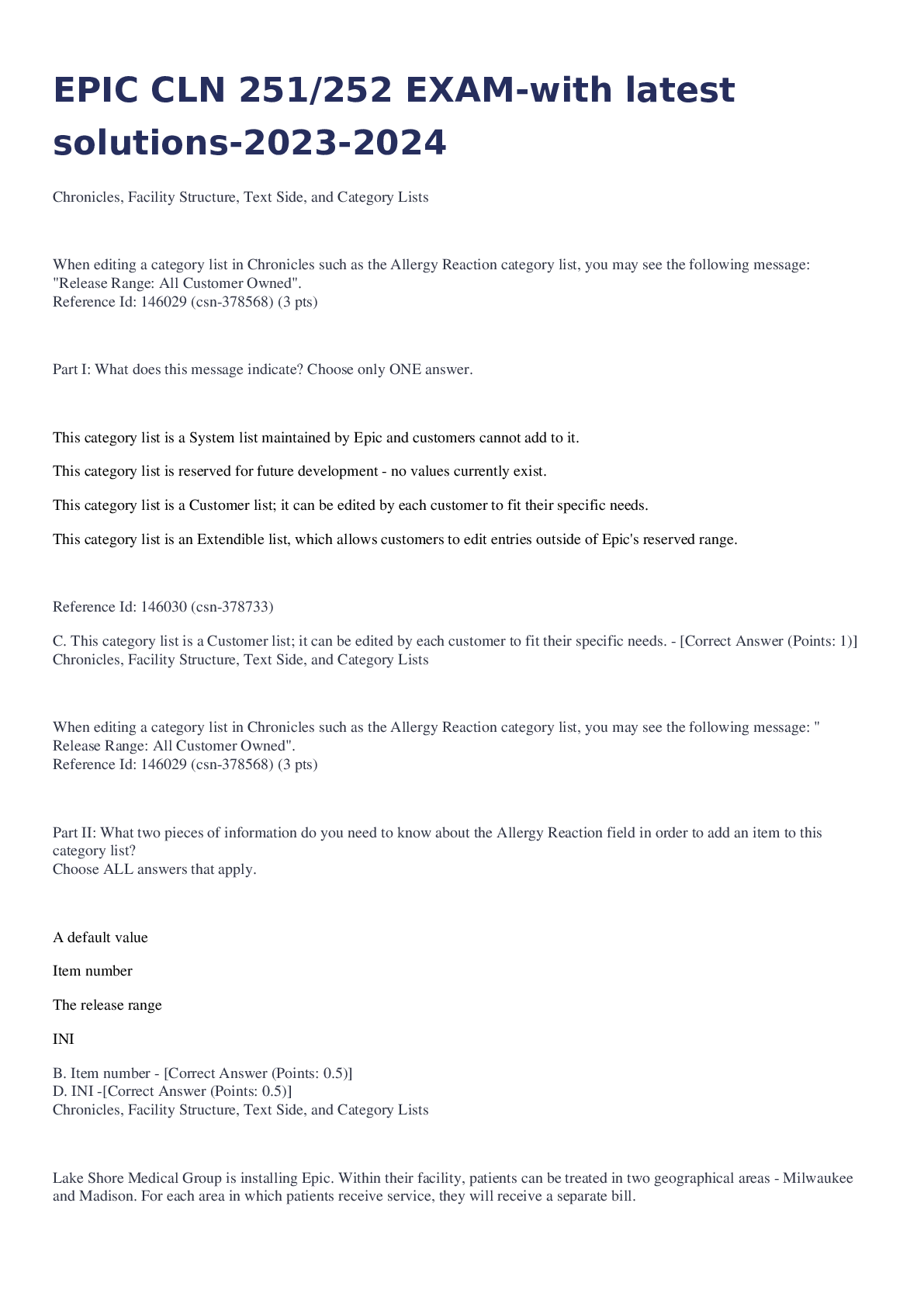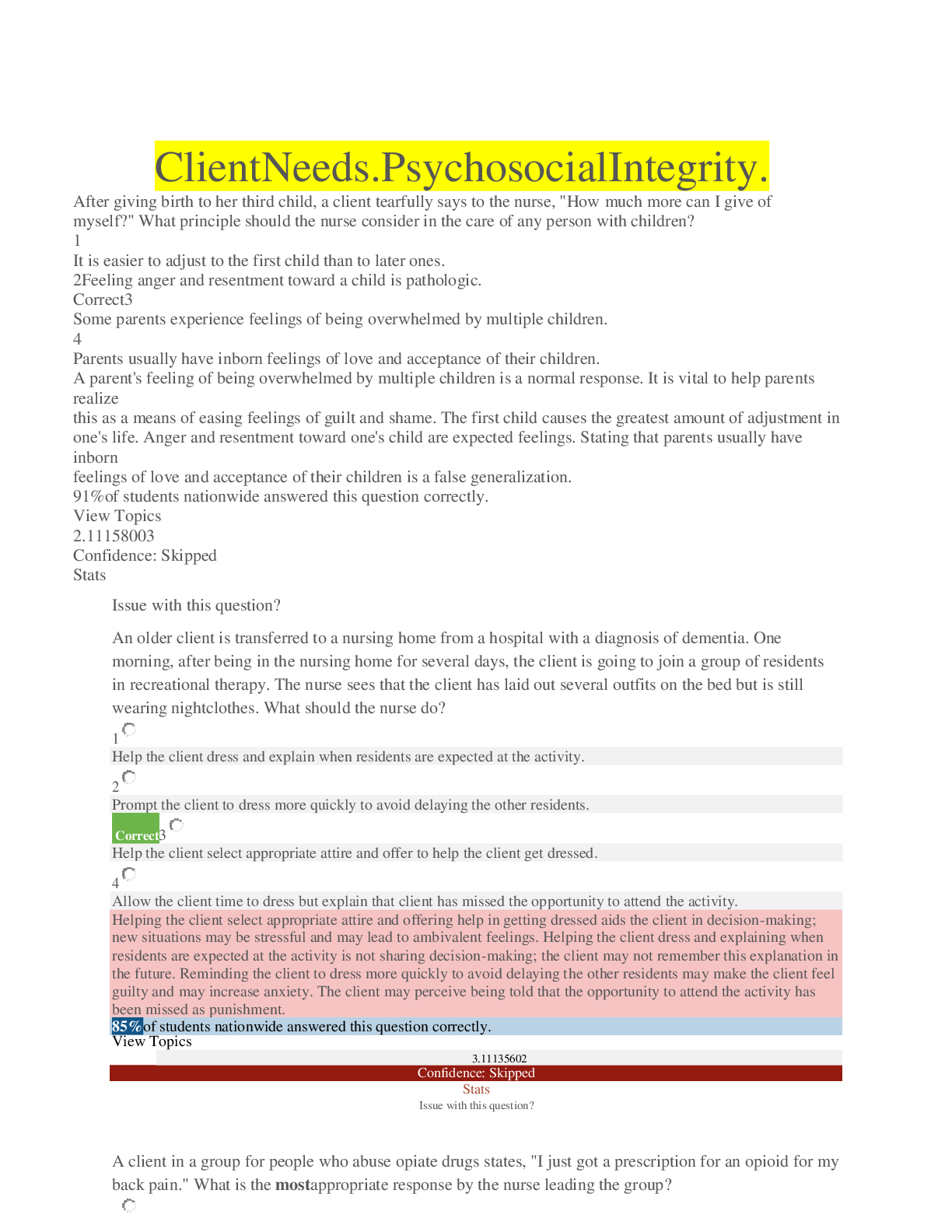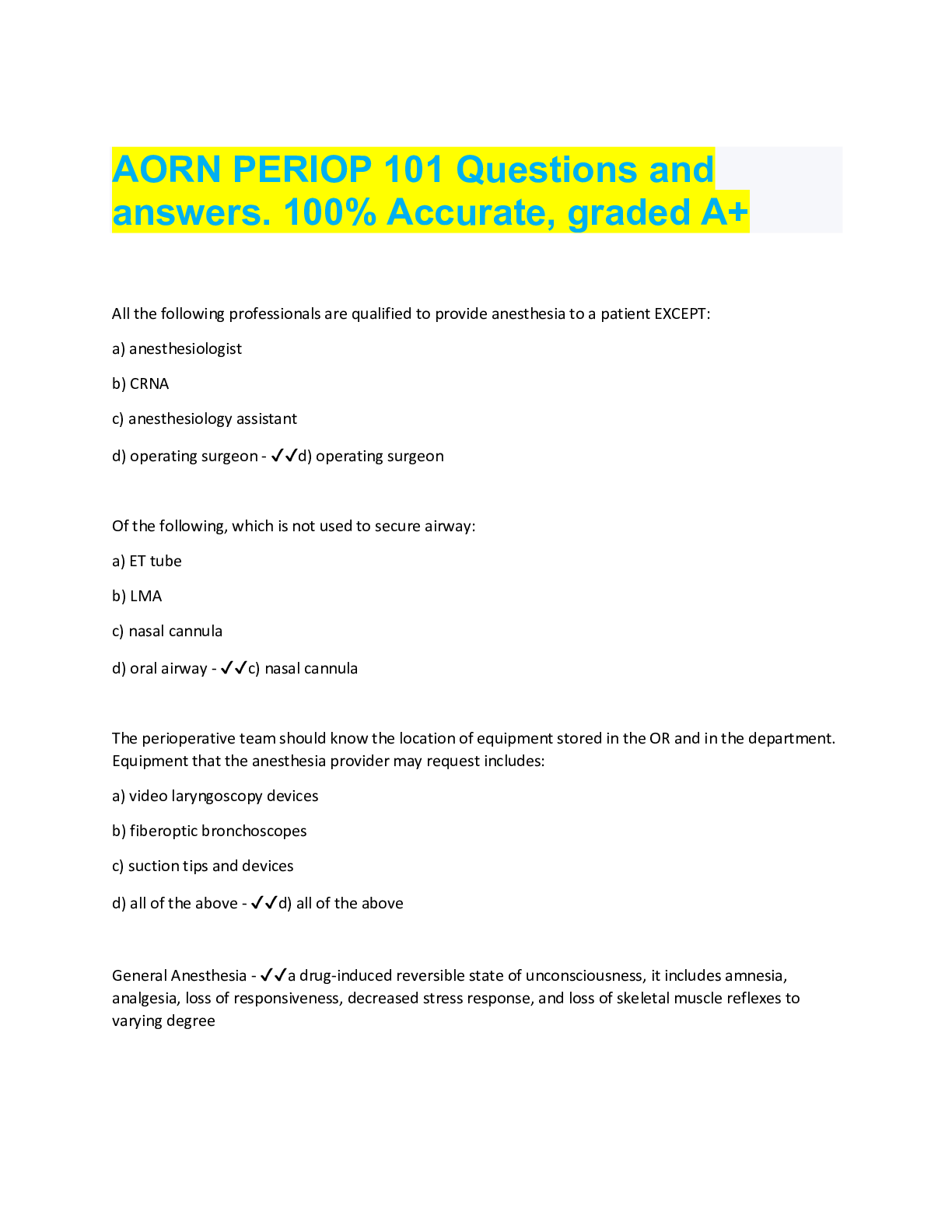ATI PHARMACOLOGY BEST REVISION GUIDE-QUESTIONS,ANSWERS AND RATIONALES
Document Content and Description Below
.A healthcare professional administers epoetin alfa (Epogen) subcutaneously to a patient who has renal failure. The healthcare professional should monitor the patient for which of the following advers... e effects? a) Hypotension b) Hypertension c) Hyperkalemia d) Dyspnea 2. Within how many hours after the onset of a stroke must fibrinolytics be started to dissolve the blood clot blocking the artery? a) Within 12 hours b) Within 3 hours c) Within 6 hours d) Within 4-8 hours 3. A patient who is taking ferrous sulfate (feosol) to treat iron deficiency anemia develops severe nausea and vomiting due to iron toxicity. Which of the following drugs should the healthcare professional use to treat this complication? a) Flumazenil (Mazicon) b) Acetylcysteine (Acetadote) c) Naloxone d) Deferoxamine (desferal) 4. After taking Atorvastatin (Lipitor) the patient reports brown urine, the nurse should recognize this adverse effect as: a) Gastrointestinal bleeding b) Inotropic effect c) Dysphasia d) Rhabdomyolysis 5. A patient who is taking warfarin (Coumadin) arrives at the emergency department and reports rectal bleeding. Which of the following drugs should the healthcare professional have available? a) Filgrastim b) Vitamin K c) Deferoxamine d) Protamine 6. A patient is about to begin taking alteplase (Activase) to treat acute myocardial infarction. The healthcare professional should understand the drug is most effective when the patient receives it: a) 24 hours after clot formation b) After initiation of anticoagulants c) Prior to cot formation d) Within 3 hours of symptoms onset 7. A nurse is caring for a client who has a prescription for clopidogrel. The nurse should monitor the client for which of the following adverse effects? a) Bleeding b) Hypotension c) Constipation d) Insomnia 8. A nurse is caring for a client who is receiving heparin to treat deep-vein thrombosis. The client begins vomiting blood. After stopping the heparin infusion, which of the following medications should the nurse expect the RN to administer? a) Vitamin K b) Atropine c) Protamine sulfate d) Calcium gluconate 9. A Health Care Provider is caring for a patient who is about to begin taking epoetin alfa (Epogen). Which of the following lab values should increase with effective therapy? a) PT b) WBC c) Hgb d) Platelets 10. The patient has started taking niacin for her high cholesterol. Which of the following side effects is common in a patient taking niacin? a) Flushing b) Hyperuricemia c) Glucose Tolerance d) Constipation 11. A healthcare professional is preparing to administer the prescribed dose of filgrastim (Neupogen) to a patient. The patient laboratory results indicate that the patient has a WBC count of 12,000/mm3. Which of the following actions should the healthcare professional take? a) Clarify the prescription with the provider b) Administer the drug with an analgesic c) Limit venipunctures d) Assess breathing sounds 12. A nurse is assessing a client who is taking amiodarone to treat atrial fibrillation. Which of the following findings is a manifestation of amiodarone toxicity? a) Productive cough b) Light yellow urine c) Report tinnitus d) Blue gray skin discoloration 13. A healthcare professional is caring for a patient who has a known sensitivity to E-Coli derived proteins. This sensitivity is a contraindication for which of the following drugs? a) Epoetin alfa (Erythropoietin) b) Oprelvekin (Neumega) c) Alteplase (Activase) d) Filgrastim (Neupogen) 14. A nurse is caring for an older adult client who has a new prescription for digoxin and takes several other medications. Concurrent use of which of the following medications places the client at risk for digoxin toxicity? a) Verapamil b) Phenytoin c) Warfarin d) Aluminum hydroxide 15. A healthcare professional is assessing a patient following the administration of nifedipine (Procardia). Recognizing the adverse effects of nifedipine, the healthcare professional should be prepared to administer which of the following drugs: a) prazosin (Minipress) b) doxazosin (Cardura) c) enalapril (Vasotec) d) propranolol (Inderal) 16. A healthcare professional is caring for a patient who is about to begin taking verapamil (Calan) to treat atrial fibrillation. The healthcare professional should tell the patient to avoid grapefruit juice while taking verapamil because it can cause? a) Hypotension b) Tachycardia c) Dehydration d) Diarrhea 17. A nurse is caring for a client who has a new prescription for captopril for hypertension. The nurse should monitor the client for which of the following adverse effects? a) Neutropenia b) Hypokalemia c) Hypernatremia d) Bradycardia 18. A healthcare professional is reviewing the history of a patient who is about to begin furosemide (Lasix) therapy to treat Hypertension. Which of the following drugs that the client takes should alert the healthcare professional to take further action? A.) Lithium (Lithobid) for bipolar disorder B.) Phenytoin (Dilantin) for a seizure disorder C.) Erythromycin (Erythrocin) for bronchitis D.) Warfarin (Coumadin) to prevent blood clots 19. A nurse is providing teaching to a client who has a new prescription for digoxin. The nurse should instruct the client to monitor and report which of the following adverse effects is a manifestation digoxin toxicity? Select all that apply. a) Constipation b) Rash c) Diplopia d) Fatigue e) Anorexia 20. A health-care professional is caring for a patient who is about to begin taking oprelvekin (Neumega) to treat thrombocytopenia. The health-care professional should tell the patient to report which of the following indications of an adverse reaction? (Select all that apply). a) Conjunctivitis b) Palpitations c) Swollen ankles d) Jaundice e) Tinnitus 21. A healthcare professional should question the use of nifedipine (Procardia) for a patient who has history of which of the following? a) Unstable Angina Pectoris b) Liver disease c) Bradycardia d) Second-degree AV block 22. A patient who is taking digoxin (Lanoxin) develops ECG changes and other manifestations that indicate severe digoxin toxicity. Which of the following drugs should the healthcare professional have available to treat this complication? a) Acetylcysteine (Acetadote) b) Flumazenil (Mazicon) c) Deferoxamine (Desferal) d) Fab antibody fragments (Digibind) 23. A healthcare professional is caring for a patient who is about to begin taking warfarin (Coumadin). The healthcare professional should caution the patient about taking which of the following OTC drugs? a) Diphenhydramine (Benadryl) b) Dimenhydrinate (Dramamine) c) Calcium carbonate (Tums) d) Ibuprofen (Motrin) 24. A healthcare professional is caring for a patient who is about to begin using transdermal nitroglycerin (Nitro-Dur) to treat angina pectoris. When talking with the patient about the drug, the healthcare professional should include which of the following instructions? (select all that apply). a) Apply a new patch at the onset of anginal pain b) Apply the patch to dry skin and cover the area with plastic wrap c) Apply the patch to a hairless area and rotate sites d) Apply a new patch each morning e) Remove patches for 10-12 hours daily 25. A nurse is caring for a client who has unstable angina. The nurse should anticipate a prescription from the provider for which of the following medications? a) Epinephrine b) Lidocaine c) Atropine d) Nitroglycerin 26. A nurse is caring for a client who recently started alteplase therapy. The nurse should monitor the client for which of the following? a) Hypertension b) Bronchodilation c) Headache d) Edema 27. A health care provider is caring for a patient who is going to start taking losartan (Cozaar) to treat hypertension. The health care provider should tell the patient to report which adverse effect? a) Sleepiness b) Peripheral edema c) Constipation d) Facial edema 28. A nurse is reinforcing discharge teaching with a client who has venous thrombosis and a prescription for warfarin. Which of the following instructions should the nurse include in the teaching? a) Take ibuprofen as needed for headaches or other minor pains b) Report to the laboratory weekly to have blood drawn for aPTT c) Increase intake of dark green vegetables d) Carry a medical alert ID card 29. A health professional is about to administer atenolol (Tenormin) to a patient who has hypertension. Which of the following assessments should the health care professional perform prior to giving the patient the drug? a) Respiratory rate b) Level of consciousness c) Serum glucose d) Apical pulse 30. A nurse is assessing a client who is taking digoxin to treat heart failure. Which of the following findings is a manifestation of digoxin toxicity? a) Bruising b) Report of metallic taste c) Muscle pain d) Report of anorexia 31. A patient is taking digoxin 0.125 mg every morning. The LPN/LVN checks the apical pulse and determines the heart rate to be 58 beats/min. Which of the following actions is appropriate for the LVN to take? a) Ask patient to drink a cup of coffee and return in a hour. b) Hold drug and notify healthcare provider. c) Give the drug and document on medical record. d) Give the drug and notify the healthcare provider. 32. In what organ does the majority of the drug’s biotransformation occur? a) Heart b) Spleen c) Liver d) Kidneys 33. A nurse is reinforcing teaching with a client who has tuberculosis and a prescription for rifampin. The nurse should identify which of the following findings as a harmless and expected adverse effect of rifampin? a) Red-orange discoloration of urine b) Increased ecchymosis c) Yellow appearance of the sclerae d) Lack of energy What administration considerations apply to Digoxin? What administration consideration apply to lidocaine? What administration consideration apply to warfarin? 34. A nurse is preparing to administer nitroglycerin topical ointment to a client who has angina. Which of the following actions should the nurse take? a) Cover the applied ointment with cotton gauze b) Apply the ointment using a dose-measuring applicator c) Apply the ointment using the index finger d) Massage the ointment onto the client’s skin 35. A healthcare professional is caring for a patient who is about to begin taking conjugated equine estrogen (Premarin). The healthcare professional should tell the patient to report which of the following indications of a serious adverse reaction? a) Vaginal Bleeding b) Hot flashes c) Urinary tract infection d) Bone pain 36. A nurse is reinforcing teaching with a client who is to start taking hydrochlorothiazide for hypertension. The nurse instructs the client to eat foods rich in potassium. Which of the following statements by the client indicates and understanding of the teaching? a) "This medication will not work unless I have enough potassium." b) "This medication may cause a loss of potassium." c) "Potassium will increase the therapeutic effect of my blood pressure medication." d) "Potassium will lower my blood pressure." 37. A healthcare professional should assess a patient who has a megaloblastic anemia for indications of which of the following deficiencies? a) Vitamin B12 b) Vitamin K c) Vitamin C d) Vitamin D 38. When talking with a patient about taking eplerenone (Inspra) to treat hypertension, the health care provider should include which instructions: a) Avoid drinking grapefruit juice. b) Avoid the use of salt substitutes. c) Use sunscreen and protective clothing. d) Stop taking the drug if dizziness occurs. 39. When talking with a patient about taking amiodarone (Cordarone) to treat atrial fibrillation, which of the following should the healthcare professional tell the patient to avoid? a) Grapefruit Juice b) Milk c) Foods high in vitamin K d) NSAIDs 40. A healthcare professional is caring for a patient who is taking spironolactone (Aldactone) to treat hypertension. Which of the following laboratory values should alert the health care professional to take further action? a) Serum sodium level of 140 mEq/L b) Serum potassium level of 5.2 mEq/L c) Serum chloride level of 100 mEq/L d) Serum magnesium level of 1.9 mEq/L CONTINUED,...DOWNLOAD FOR BEST REVISION AND SCORES [Show More]
Last updated: 1 year ago
Preview 1 out of 77 pages
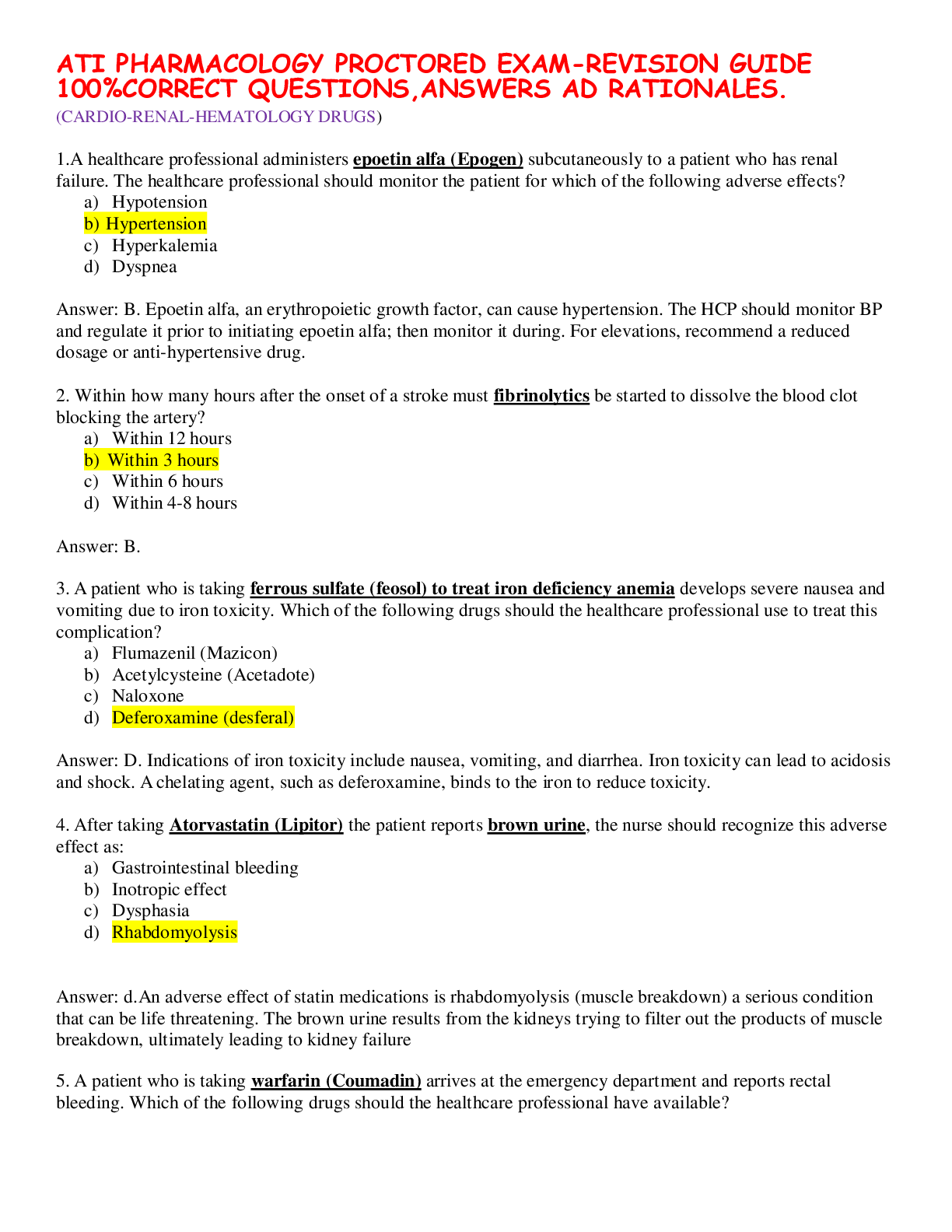
Reviews( 0 )
Document information
Connected school, study & course
About the document
Uploaded On
May 12, 2021
Number of pages
77
Written in
Additional information
This document has been written for:
Uploaded
May 12, 2021
Downloads
0
Views
52

